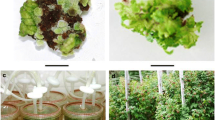Abstract
The leaf, petiole, stem and root anatomy of an aseptically cultured red raspberry clone (Rubus idaeus L.) was studied before and 5 weeks after transfer to soil under controlled environmental conditions. Tissues persistent from culture showed little or no change with time in soil; they grew minimally and slight secondary wall deposition occurred. New organs formed in successive weeks after transplantation showed a graded increase in potential size and development. Some features, such as collenchyma formation, rapidly returned to control levels; this was seen in new leaves expanding in the first week after transplantation. Other features, such as sclerenchyma formation, did not occur in leaves expanding during the first 2 weeks after transplantation, even when these were a month or more in age. Some sclerenchyma was seen in leaves expanding in the third week after transplantation, increasing in later-formed leaves. Increasing the light intensity of transplant accelerated the return to control-type organ size and appearance. During acclimatization transitional forms of leaves, petioles, stems and roots develop that ranged anatomically from culture-to control-type. This trend is analagous to the normal developmental sequence of organ formation as it affects the potential for development of successily formed organs.
Similar content being viewed by others
References
Brainerd KE, Fuchigami LH (1981) Acclimatization of aseptically cultured apple plants to low relative humidity. J Amer Soc Hort Sci 106:515–518
Brainerd KE, Fuchigami LH (1982) Stomatal functioning of in vitro and greenhouse apple leaves in darkness, mannitol, ABA and CO2. J Expt Bot 33:388–392
Brainerd KE, Fuchigami LH, Kwiatkowski S, Clark CS (1981) Leaf anatomy and water stress of aseptically cultured ‘Pixy’ plum grown under different environments. HortScience 16:173–175
Donnelly DJ, Vidaver WE (1984a) Leaf anatomy of red raspberry transferred from culture to soil. J Amer Soc Hort Sci 109:172–176
Donnelly DJ, Vidaver WE (1984b) Pigment content and gas exchange of red raspberry in vitro and ex vitro. J Amer Soc Hort Sci 109:177–181
Donnelly DJ, Stace-Smith R, Mellor FC (1980) In vitro culture of three Rubus species. Acta Hort 112:69–75
Eberhardt P (1903) Influence de l'aire sec et de l'air humide sur la forme et sur la structure des vegetaux. Ann Sci nat Bot, Ser VIII, 18:60–152
Esau K (1965) Anatomy of seed plants. (2nd ed) John Wiley & Sons. Inc. New York
Fisher FJF (1954) Effect of temperature on leaf-shape in Ranunculus. Nature 173:406
Fisher FJF (1960) A discussion of leaf morphogenesis in Ranunculus hirtus. NZJ Sci, 3:685–693
Fuchigami LH, Cheng TY, Soeldner A (1981) Abaxial transpiration and water loss in aseptically cultured plum. J Amer Soc Hort Sci 106:519–522
Grout BWW (1975) Wax development on leaf surfaces of Brassica olerace var. Currawong regenerated from meristem culture. Pl Sci Lett 5:401–405
Grout B, Aston MJ (1977a) Transplanting of cauliflower plants regenerated from meristem culture I. Water loss and water transfer related to changes in leaf wax and to xylem regeneration. Hort Res 17:1–7
Grout B, Aston MJ (1977b) Transplanting of cauliflower plants regenerated from meristem culture II. Carbon dioxide fixation and the development of photosynthetic ability. Hort Res 17:65–71
Grout B, Aston MJ (1978) Modified leaf anatomy of cauliflower plantlets regenerated from meristem culture. Ann Bot 42:993–995
Manning CE, Miller DG, Teare ID (1977) Effect of moisture stress on leaf anatomy and water use efficiency of peas. J Amer Soc Hort Sci 102:756–760
Metcalfe CR, Chalk L (1950) Anatomy of the dicotyledons. Vol. 1 Clarendon Press, Oxford
Poole RT, Conover CA (1983) Establishment and growth of in vitro-cultured Dieffenbachia. HortScience 18:185–187
Razdorskii VF (1955) Arkhitektonika rastenii. (Architectonics of plants). Moskva, Sovetskaia Nauka
Sass JE (1958) Botanical microtechnique, (3rd ed) Iowa State University Press, Ames, Iowa
Sutter E, Langhans RW (1979) Epicuticular wax formation on carnation plantlets regenerated from shoot tip culture. J Amer Soc Hort Sci 104:493–496
Venning FD (1949) Stimulation by wind motion of collenchyma formation in celery petioles. Bot Gaz 110:511–514
Wangermann E (1961) The effect of water supply and humidity on growth and development. p 618–633. In: Encyclopedia of plant physiology. W.Ruhland (ed) Vol 16. Springer Verlag, Berlin.
Wardle K, Quinlan A, Simpkins I (1979) Abscisic acid and the regulation of water loss in plantlets of Brassica oleracea var. botrytis regenerated through apical meristem culture. Ann Bot 43: 745–752
Wardle K, Dobbs EB, Short KC (1983) In vitro acclimatization of aseptically cultured plantlets to humidity. J Amer Soc Hort Sci 108: 386–389
Wetzstein HY, Sommer HE (1982) Leaf anatomy of tissue cultured Liquidambar styraciflua (Hamamelidaceae) during acclimatization. Amer J Bot 69: 1579–1586
Wetzstein HY, Sommer HE (1983) Scanning electron microscopy of in vitro-cultured Liquidambar styraciflua plantlets during acclimatization. J Amer Soc Hort Sci 108: 475–480
Ziv M, Meir G, Halevy AH (1983) Factors influencing the production of hardened glaucus carnation plantlets in vitro. Plant Cell, Tissue Organ Culture 2: 55–65
Author information
Authors and Affiliations
Rights and permissions
About this article
Cite this article
Donnelly, D.J., Vidaver, W.E. & Lee, K.Y. The anatomy of tissue cultured red raspberry prior to and after transfer to soil. Plant Cell Tiss Organ Cult 4, 43–50 (1985). https://doi.org/10.1007/BF00041654
Received:
Accepted:
Issue Date:
DOI: https://doi.org/10.1007/BF00041654




